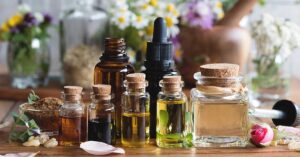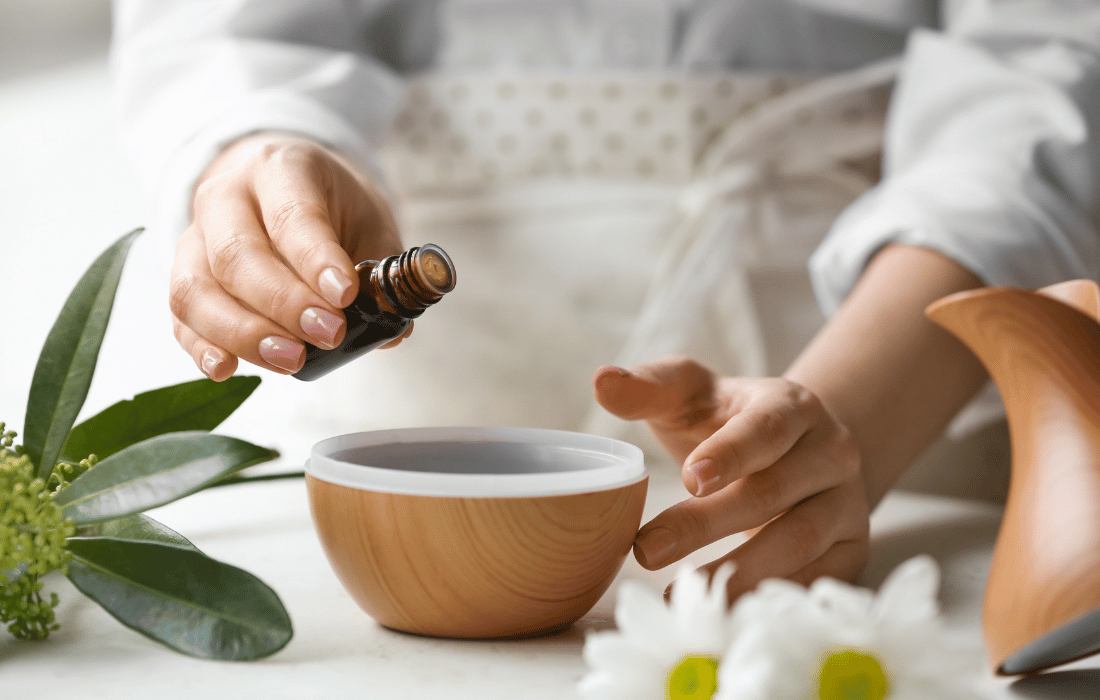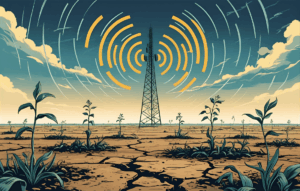Essential oils have become a popular choice for those seeking natural alternatives to synthetic fragrances and chemicals in everyday products. From lavender to peppermint, these oils are touted for their therapeutic properties—helping with relaxation, stress reduction, and even improving sleep. But over the last several years, concerns have been raised about whether certain essential oils could act as endocrine disruptors, potentially affecting hormone levels in the body.
As someone who uses essential oils sparingly and prefers to avoid specific oils like lavender and tea tree due to these concerns, I believe it’s crucial to explore this topic with nuance. There’s a lot of conflicting information out there, so let’s break down the science, look at the research, and figure out how to safely enjoy essential oils without worrying about long-term hormonal impacts.
What Are Endocrine Disruptors?
First, let’s establish what we mean by endocrine disruptors. These are chemicals that interfere with the normal functioning of the endocrine system, which is responsible for producing and regulating hormones. Hormones play a critical role in controlling many processes in the body, including growth, metabolism, reproduction, and mood.
Endocrine disruptors can mimic or block hormones, leading to imbalances that might contribute to health issues like developmental problems, reproductive disorders, or metabolic diseases. BPA (bisphenol A), found in some plastics, and phthalates, often found in synthetic fragrances, are well-known examples of endocrine disruptors.
But can essential oils—which are derived from plants and have a natural, therapeutic allure—also disrupt our hormones?
Lavender and Tea Tree Oils: The Research that Sparked Concern
The discussion around essential oils as endocrine disruptors began in 2007 with a study that linked lavender and tea tree oils to cases of prepubertal gynecomastia, a condition where young boys develop breast tissue. The researchers suggested that these oils could have estrogenic (mimicking estrogen) and anti-androgenic (blocking testosterone) properties. Following this, other studies emerged, further examining the hormonal impacts of these oils.
Some of the key studies in this field include:
The New England Journal of Medicine (2007): This study linked lavender and tea tree oils to prepubertal gynecomastia in boys. The findings suggested that regular exposure to these oils might contribute to hormonal imbalances.
Pediatric Annals (2012): This research continued to explore the possible link between gynecomastia and the topical use of lavender and tea tree oils in personal care products.
De Gruyter (2016): Focused on chronic exposure to lavender oil, particularly in personal care products, and its potential effects on prepubertal boys.
Endocrine Society (2018): This study investigated the hormonal actions of specific compounds in lavender and tea tree oils, supporting the idea that these oils might affect estrogen and testosterone receptors.
Following these studies, various pediatric and health groups recommended avoiding the use of lavender and tea tree oils in young children, especially in products like lotions, shampoos, and diffusers. These oils quickly gained a reputation as potential hormone disruptors.
The Role of Methodology: Are These Studies Enough to Prove a Link?
Before jumping to conclusions, it’s essential to examine the quality and limitations of the studies. While case reports and small-scale studies provide valuable insights, they often suffer from limitations like recall bias and inconsistent exposure confirmation. For instance, some studies relied on parents’ memories of what products their children used, which isn’t always the most reliable data.
One of the main concerns is that many of the studies linking essential oils to endocrine disruption rely on in vitro (lab-based) research, which examines the effects of isolated compounds in a controlled setting. These studies are useful for understanding potential biological mechanisms but don’t always reflect how substances behave in the complex environment of the human body.
Additionally, there has been no large-scale epidemiological research that definitively proves lavender or tea tree oil causes endocrine disruption in humans. Without this kind of rigorous, population-based study, it’s challenging to confirm whether the effects observed in small groups or under lab conditions translate to real-world scenarios.
This is where the Bradford Hill criteria come into play—a set of principles used in epidemiology to determine whether an observed association is likely to be causal. Let’s briefly apply these criteria to the question of essential oils as endocrine disruptors:
Temporality: Does exposure to essential oils precede the hormonal effects? In the studies cited, the timing of exposure relative to the onset of symptoms was often unclear.
Strength: The association between essential oil use and endocrine disruption is weak in terms of statistical significance. While some cases have been reported, they are not numerous enough to suggest a strong link.
Consistency: Studies have produced inconsistent results, with some showing effects and others failing to replicate the findings.
Biological Gradient: There is no established dose-response relationship—meaning we don’t know if higher exposure to these oils increases the likelihood of hormonal disruption.
Plausibility: Lab studies have shown that certain compounds in these oils may have estrogenic or anti-androgenic effects, providing some biological plausibility, but this has not been confirmed in human studies.
In summary, while the research raises valid concerns, the evidence does not meet the threshold for proving a definitive causal link. It’s still a hypothesis that needs further investigation through well-designed epidemiological studies.
Systematic Reviews: A Closer Look at the Evidence
In 2021, a systematic review was published by the National Association for Holistic Aromatherapy (NAHA) and other organizations to critically evaluate the existing evidence on essential oils and endocrine disruption. The review sought to answer whether there was any solid clinical evidence linking lavender or tea tree oil to hormonal issues.
Key Findings of the NAHA Review:
The review found no clinical evidence that tea tree or lavender oil exposure was definitively linked to endocrine-disrupting outcomes like prepubertal gynecomastia or premature thelarche (early breast development in girls).
The level of exposure confirmation in different studies varied significantly. Some studies relied solely on parental recall of product use, while others conducted laboratory analyses to verify the presence of essential oils or their chemical components.
Exposure methods also differed—some subjects were exposed to essential oils via personal care products like lotions and shampoos, while others inhaled them through diffusers. This inconsistency makes it difficult to draw firm conclusions.
Overall, the review concluded that while some case reports suggest a link between essential oil exposure and hormone disruption, larger, well-designed studies are needed before any definitive claims can be made. The available evidence does not support widespread alarm but does warrant caution, especially for frequent, high-exposure scenarios.
Quality Matters: The Importance of Pure and Organic Essential Oils
 While the research is still ongoing, one factor that can’t be ignored is the quality of essential oils. Not all essential oils are created equal. Some commercial products are diluted with synthetic chemicals, which can exacerbate any potential risks. To minimize the chance of exposure to harmful additives, it’s essential to use 100% pure, organic essential oils from reputable brands.
While the research is still ongoing, one factor that can’t be ignored is the quality of essential oils. Not all essential oils are created equal. Some commercial products are diluted with synthetic chemicals, which can exacerbate any potential risks. To minimize the chance of exposure to harmful additives, it’s essential to use 100% pure, organic essential oils from reputable brands.
Here’s why quality matters:
Purity: Pure essential oils are free from additives and synthetic chemicals, which can be harsh on the skin and potentially toxic when inhaled or absorbed.
Organic Certification: Organic essential oils are produced without the use of pesticides and other harmful chemicals that could add to the body’s toxic load. This is especially important for oils applied to the skin or used in personal care products.
Testing: Reputable companies often provide GC/MS reports (Gas Chromatography/Mass Spectrometry) for their essential oils, which can verify the purity and composition of the oil. Always check for this information when purchasing essential oils.
Using high-quality essential oils ensures that you’re getting the therapeutic benefits without unnecessary risks from low-grade or adulterated products.
Practical Tips for Safe Use of Essential Oils
If you enjoy essential oils but want to avoid potential hormonal effects, here are some practical tips to minimize risk:
Dilute Properly: Always dilute essential oils with a carrier oil like coconut or jojoba oil before applying them to your skin. A dilution of 1-2% is usually sufficient for most uses.
Rotate Oils: Rather than using the same oils consistently, try rotating between different types. This can reduce the chance of overexposure to any one oil.
Avoid Overexposure: Limit your use of essential oils in closed spaces and avoid diffusing them for long periods in enclosed rooms. Keep rooms well-ventilated to minimize inhalation of concentrated vapors.
Patch Test: If you’re new to using an essential oil, always do a patch test on a small area of skin to ensure you don’t have a sensitivity or allergic reaction.
Consult a Professional: If you have hormonal imbalances or are concerned about potential endocrine disruption, consult a healthcare provider or a certified aromatherapist before incorporating essential oils into your wellness routine.
Conclusion: Balance is Key
The question of whether essential oils, particularly lavender and tea tree, are endocrine disruptors is still open for debate. The early research suggested a potential link, but systematic reviews and larger studies have yet to provide conclusive evidence. As with many natural products, moderation and quality are key.
Personally, I avoid lavender and tea tree oils due to ongoing concerns but continue to use other essential oils sparingly and only from trusted sources. In comparison to synthetic fragrances, which are well-documented endocrine disruptors, I find essential oils to be a much safer, more natural alternative—especially when sourced from reputable brands that offer pure, organic oils.
In the end, it’s about making informed choices, understanding the nuances of the science, and using essential oils in a way that supports your health and wellness without unnecessary risks.













